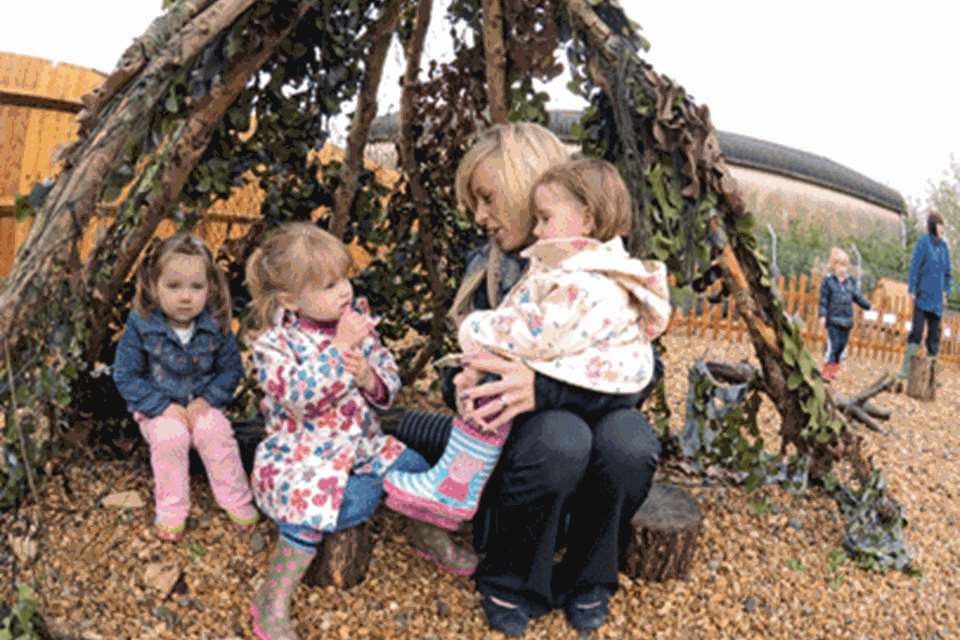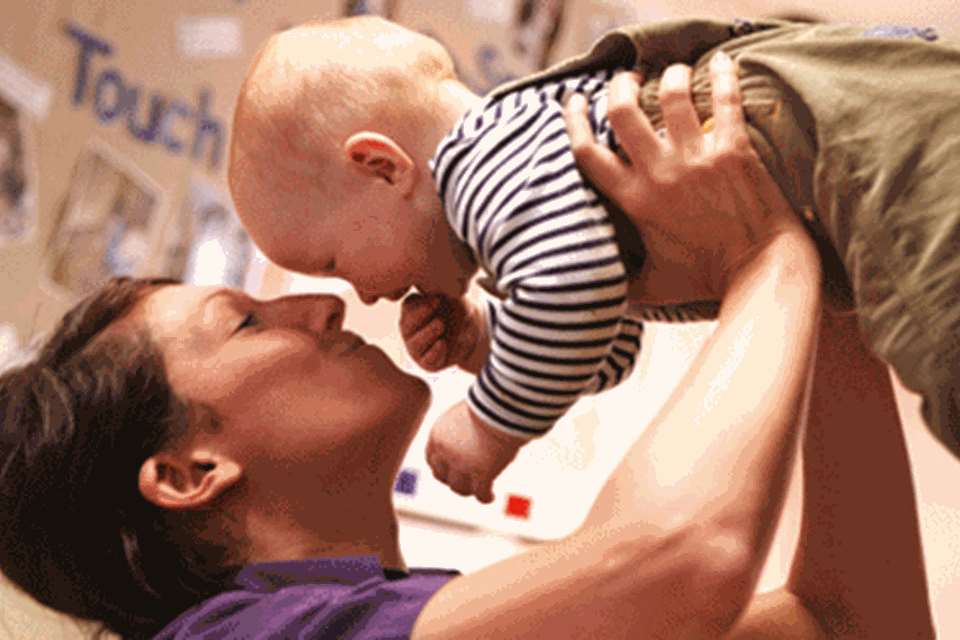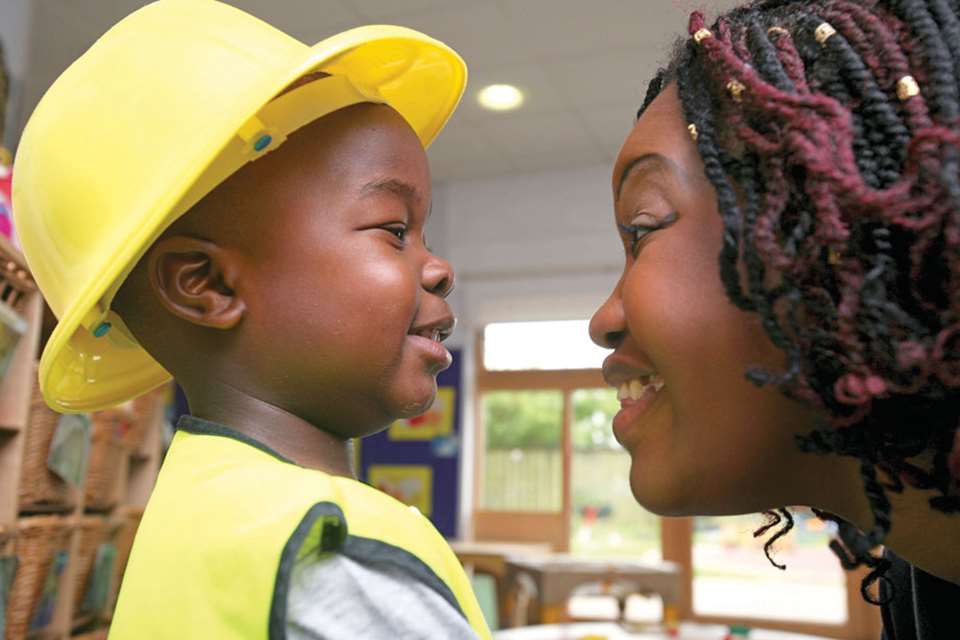Learning & Development C&L: In the moment
Ruth Thomson
Monday, February 24, 2014
Children benefit enormously language-wise when practitioners and parents dedicate time to meaningful interaction, says Michael Jones.

Engaging in meaningful interaction and conversation is central to children's language learning. For young children, the most meaningful communication involves adults commenting on what children are doing and responding to their comments and questions, while adults ask relevant questions of their own. However, the biggest challenge for practitioners, particularly in pre-schools and foundation classes, is the ratio of many children to few adults.
For several years, my colleagues and I have been tussling with the vexed question of how we can have such detailed interactions and conversations with children. These are particularly important for children learning English as an additional language and those who are at risk of language delay.
The England-wide Every Child a Talker (ECaT) project went some way towards addressing this issue, though it ended after two years, in 2010. Some local authorities have been able to continue the work of ECaT, including Hampshire County Council's Let's Keep Talking project.
Whenever I visit settings, I know that I can interact and converse with children for as long as I like and for as long as the children are interested. It's easy for me, because I am in the fortunate position of being a visitor whose only duty within the setting is to focus entirely on talking and playing with children. That makes me very popular with the children, and particularly with those who are quiet.
From my experience, young children who are very quiet have this reaction because they feel vulnerable and unsure. One of the things they are most unsure about is how to attract and maintain an adult's attention, bearing in mind that they will have to compete with other children who are more confident talkers, or those whose challenging behaviour disrupts the adult's concentration, or even leads to the adult moving away.
Many shy children in the early stages of learning English as an additional language are equally vulnerable, because they are not getting enough practice of talking with adults. This is typically because they too lack the ability to keep the adults focused on talking, leading to them remaining on the periphery of activities, passively observing what others are doing.
QUALITY OF INTERACTION
I occasionally lead training for practitioners in Hounslow, west London, which led me to meet speech and language therapist Bhavna Acharya and early years consultant Debbie Brace. Bhavna and Debbie lead Hounslow's Let's Talk Together project, a continuation of ECaT. The central theme is the quality of interaction and conversation between adults and children.
Debbie leads training to support parents who need help interacting with their babies. These Baby Talk and Play sessions hold a key to unlocking one of the problems we can have with quality interaction: lack of time. Parents, particularly if they have more than one child, can find it difficult to find time for the quality interactions they would like to have with their baby.
Debbie has developed the concept of 'being in the moment', where parents are encouraged to focus entirely on their child, even if only for a few short minutes at intervals during the day. This interaction can take place during intimate care routines such as nappy changing and helping baby to go to sleep. These intense moments of communication are important for baby and parent as they cement the bonding process between them, and provide the baby with security and reassurance that are vital for communication and language development.
The concept of 'being in the moment' is also at the heart of the Positive Interaction training sessions run by Debbie and Bhavna. These day courses for practitioners highlight the importance of developing strategies and practice for language development, with a particular focus on interactions between practitioners and children. The training can include sessions in settings, looking specifically at individual practitioners' interaction styles and skills.
Central to the work in settings is supporting practitioners to film each other interacting with children, then analysing sequences to identify what the adults are doing well, followed by introducing techniques that improve interaction and conversation. The trainers aim to increase adults' overall responsiveness, including reducing the amount of adult questioning of children, while increasing the number of comments they make about what children are doing.
These ideas are in line with general good practice that was developed through ECaT and other projects for language development. However, Positive Interaction directly addresses the fundamental question that is asked by staff in nursery and reception classes in particular; that is, 'How can we become more responsive when we work within a ratio of one adult to 13 children?'
The answer is the concept of 'the planted adult'.
THE PLANTED ADULT
What this means is that an adult plans to stay with children in one particular place for a given amount of time. As Bhavna describes it, 'A planted adult looks like she is relaxed and interested in what the children are doing, and is going to stay put and be totally "in the moment" with the child or children with whom she is interacting. She has agreed with other adults that she will not be responsible for anything else, as these duties will be taken up by other colleagues.
'A planted adult who is using Positive Interaction techniques such as observing, waiting, listening and responding will be able to draw children into conversation and keep the talk going in the sustained way that we know is vital for learning and well-being. We are not setting up special activities for children, but getting involved with their own interests.'
This approach is particularly important for children who are unsure of how to interact, and such sessions are often the catalyst for them to move forward in their confidence to talk with adults and the other children.
Debbie and I put Positive Interaction into practice during a day of outdoor play activities for the nursery class at Bedfont Primary School in Feltham. The staff had asked me to develop outdoor play and language, and we based this on using stones, water, sand, shovels and pipes. Because these activities were naturally attractive, most of the children were outside. As a result, the majority of staff could be with them.
My role was to move around and supervise how children were involved with resources, including understanding how to use the shovels, and helping children to share and take turns. This freed colleagues to become involved totally with children's play and talk, without needing to divert their attention towards 'noises off'.
Our photograph illustrates perfectly how 'being in the moment' as a planted adult can work. Debbie could see that the children were interested in shooting different sizes of stones down the drainpipe and into the builder's tray, though weren't sure how to organise themselves to make it happen. Debbie was able to support the children to talk and play together at this activity for at least 20 minutes. During this time, various children, many of whom were learning English as an additional language, or who would not ordinarily become involved in this type of activity, were able to spend time in deep concentration - with Debbie and each other.
Debbie was equally able to concentrate on what the children were doing, while using comments to extend their involvement, which in turn encouraged the children to make comments of their own. For example, we can see Debbie commenting, 'That's a massive pebble! Ooh, there it goes.' This invited the little boy to comment on what happened, and come up with a question for Debbie to answer. The little girl was fascinated by what the other children were doing and also became involved in playing and talking with Debbie.
MORE INFORMATION
- Johnson, M, Jones, M (2012) Supporting Quiet Children: Exciting ideas and activities to help 'reluctant talkers' become 'confident talkers', Lawrence Educational
- Jones, M (2012) Keep on talking, www.nurseryworld.co.uk/1097200/
- A Keep on Talking handbook is produced by the Children's Services Department, Hampshire County Council. For more information, email: childcare@hants.gov.uk
- Jones, M, Belsten, J (2011) Let's Get Talking! Exciting ways to support children with speech and language difficulties, Lawrence Educational
- Baby Talk and Play, www.babytalkandplay.co.uk/index.html
- For more information about Positive Interaction training and London Borough of Hounslow's Let's Talk Together project, email: bhavna.acharya@hrch.nhs.uk.
Michael Jones provides training on language development in the early years. For more information, visit www.talk4meaning.co.uk










